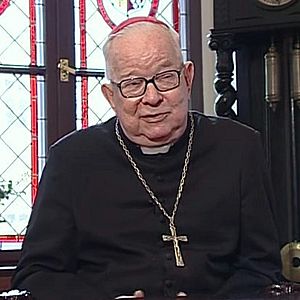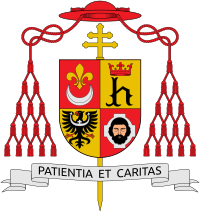Henryk Gulbinowicz facts for kids
Henryk Roman Gulbinowicz (17 October 1923 – 16 November 2020) was an important leader in the Catholic Church in Poland. He served as the Archbishop of Wrocław from 1976 to 2004. Pope John Paul II made him a cardinal in 1985, which is a very high rank in the Church. Towards the end of his life, he was asked not to appear in public.
Quick facts for kids His Eminence Henryk Roman Gulbinowicz |
|
|---|---|
| Cardinal, Archbishop Emeritus of Wrocław | |
 |
|
| Archdiocese | Wrocław |
| Appointed | 3 January 1976 |
| Reign ended | 3 April 2004 |
| Predecessor | Bolesław Kominek |
| Successor | Marian Gołębiewski |
| Other posts | Cardinal-Priest of Immacolata Concezione di Maria a Grottarossa |
| Orders | |
| Ordination | 18 June 1950 |
| Consecration | 8 February 1970 by Stefan Wyszyński |
| Created Cardinal | 25 May 1985 |
| Rank | Cardinal-Priest |
| Personal details | |
| Born | 17 October 1923 Wilno, Second Polish Republic |
| Died | 16 November 2020 (aged 97) Wroclaw, Poland |
| Denomination | Roman Catholic |
| Previous post |
|
| Motto | Patientia et Caritas (Patience and Love) |
| Coat of arms |  |
| Styles of Henryk Gulbinowicz |
|
|---|---|
 |
|
| Reference style | His Eminence |
| Spoken style | Your Eminence |
| Informal style | Cardinal |
| See | Wrocław |
Contents
Henryk Roman Gulbinowicz: A Life of Faith and Service
Early Life and Becoming a Priest
Henryk Roman Gulbinowicz was born on October 17, 1923. His birthplace was Wilno, which was then part of Poland. Today, this city is known as Vilnius, the capital of Lithuania. He grew up in a town called Szukiszki.
He decided to become a priest and began his studies at a seminary. He later moved to Białystok to continue his education. On June 18, 1950, he was ordained as a priest by Archbishop Romuald Jałbrzykowski. After working in a parish for a year, he went to Lublin. There, he studied theology at the John Paul II Catholic University of Lublin. In 1955, he earned a special degree in moral theology. From 1956 to 1959, he served as a chaplain at a university in Białystok. He also taught at a seminary in Warmia and worked in the church office in Olsztyn.
Leading the Church in Poland
On January 12, 1970, Pope Paul VI appointed Henryk Gulbinowicz as a bishop. He became the apostolic administrator for the Polish part of the Archdiocese of Vilnius. This area included Białystok. On February 8, he was consecrated as a bishop by Cardinal Stefan Wyszyński.
As a bishop, he worked to organize church activities. He also helped build new parishes. Even during wartime, he encouraged religious life in his area. He started the Parish Catechetics Center in Białystok. He also brought back a church newspaper called "Wiadomości Kościelne Archidiecezij w Białystoku."
On January 3, 1976, he became the Archbishop of Wrocław. During his time leading the church there, he created many new centers for spiritual guidance. He also started a biweekly newspaper called "Nowe Życie" (New Life). He helped crown the statue of the Virgin Mary at the famous shrine of Wambierzyce in Lower Silesia. This shrine is a popular place for pilgrimages.
In 1981, just before martial law began in Poland, a local union called Solidarity moved a large sum of money. They deposited it with Gulbinowicz. He kept the money safe from the government during a difficult time for the union.
Becoming a Cardinal
On May 25, 1985, Pope John Paul II made Henryk Gulbinowicz a cardinal. This was a great honor.
He was known as a calm and thoughtful voice within the church in Poland. While some church leaders were cautious about supporting Solidarity, Gulbinowicz often spoke up for workers. He supported Lech Wałęsa's leadership. He encouraged people who supported the union to "Hang in there, as we are hanging in." A year later, he said that Poland needed the right to have independent organizations. He believed this would help the country solve its political and economic problems.
At a ceremony marking 50 years since the Soviet invasion of Poland, he advised patience. He spoke about the efforts to rebuild Poland after the Soviet era. He said that people understood that improving the nation would require sacrifices. He also noted that Solidarity had stayed true to its principles. When the Pope visited Wrocław, Gulbinowicz spoke about tolerance. He mentioned that the city had been shaped by many different nationalities and religions over centuries.
Later Years and Legacy
On April 3, 2004, Pope John Paul II accepted Cardinal Gulbinowicz's resignation as Archbishop of Wrocław. Bishops usually retire at age 75. However, it was later clarified that his birth year was 1923, not 1928 as some documents had shown. This meant he was 80 years old when he retired. He explained that many people had adjusted their birth records during wartime to avoid forced labor. He said his true age was known to church leaders for a long time.
Cardinal Gulbinowicz also wrote several books and articles. These works focused on moral and religious topics, and on how priests are trained.
Death
Cardinal Gulbinowicz passed away on November 16, 2020, at 10:40 AM. He had been admitted to a hospital in Wrocław a few days earlier. He died due to problems with his breathing and circulation, after suffering from acute pneumonia. His remains were cremated. His ashes were buried on November 23 in his family's tomb in Olsztyn, where his parents were also buried.
See also
 In Spanish: Henryk Roman Gulbinowicz para niños
In Spanish: Henryk Roman Gulbinowicz para niños

